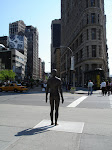This summer's torrid heat reminds me of July 1901, just before construction on the Flatiron Building began. It was so hot then that hundreds of people died. Horses, too; their carcasses lay about the streets. In Madison Park, people fought over the lovely wicker chairs-for-hire that an enterprising man who had recently arrived from England to seek his fortune had contracted with the city to place all over the parks, and in the choicest locations. Seemed like a great idea for New York, where everything was for sale, and anybody could get rich. In 1901, the economy was booming.
But the chair idea didn't fly. Because New Yorkers didn't like the idea of paying for sitting. Ha! Read more about this in my book.
In 1901, New York's economy was furiously expanding: skyscrapers were rising, subway tunnels were being dug out, and banks were getting stuffed with robber barons' money. New York is still arguably the world center of capital. But now so little gets manufactured here. Whereas in 1901 local factories were producing all manner of things that today are made overseas: construction supplies such as bricks, terra cotta, cast iron; office supplies--pens, pencils, typewriters, desks, chairs, glue; and everything having to do with the clothing trades, including thread, fabric, buttons, and the processing of ostrich feathers shipped from South Africa. Think of it, in all those old industrial lofts in the Flatiron District that are now upscale office space. In 1901, workers were toiling away there, producing tangible goods.
For an economy to thrive, it must produce something of value that others need to buy in order not just to live, but keep their own businesses running, and so forth and so forth. Obviously buying and selling just to get rich, i.e. trading in derivatives, doesn't cut it.
So how does the Flatiron District in 2010 compare to what it was 109 years ago? Yes, it is now glamorous, filled with the young partying set and establishments that cater to them. But we are in the midst of a recession, and there are plenty of vacancies. As for the skyline-altering One Madison Park, rising fifty glass-enclosed stories high, it is in foreclosure.
Subscribe to:
Post Comments (Atom)






No comments:
Post a Comment